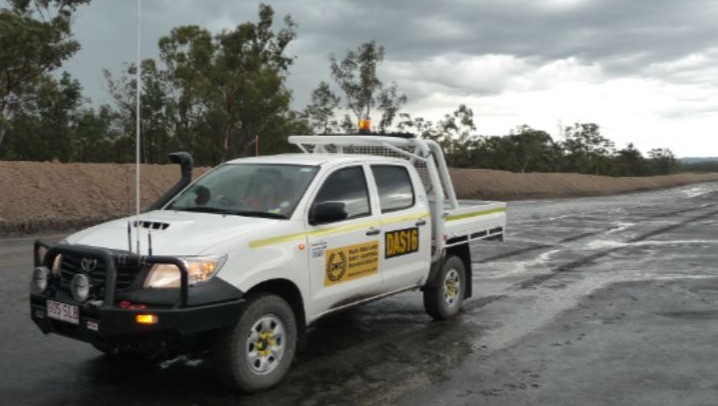
The complications associated with the overwatering of haul roads for dust suppression purposes are well documented. These highlight safety issues such as uncontrolled vehicle movements that can have serious consequences for operators and the mine. These hazards are also present during extended periods of wet weather on haul roads (particularly after long periods of dry weather).
A haul road that is dusty when it is dry can suddenly become extremely slippery and dangerous to navigate when it is wet. When haul roads become too wet, whether from heavy rain or overwatering by water bowsers, the risks of uncontrolled movements occurring is significantly increased, it becomes worse if the road surface is in bad condition or not properly stabilised.
Uncontrolled movements on haul roads caused by wet weather can include:
- Out of control sliding and skidding
- Rollovers
- Collisions on ramps
- Crashes into berms (bund walls)
- Near misses/Impacts at intersections (failure to stop, corrugations, and road pavement destabilisation
- Collisions between trucks and other vehicles on the road network
These incidents are particularly prevalent when haul traffic is required to turn, accelerate and decelerate (typically on corners, switchbacks, at intersections, declines and ramps). That being said, there have been plenty of accidents and incidents on completely flat straight haul roads over the years, making the issue of haul road safety a concern that must be addressed site-wide.
The problems associated with wet roads go beyond safety risks
Other costly repercussions of too much water on haul roads are the effects water has on the quality of the haul road surface itself.
Excessive watering (or constant watering on roads) washes away the compacted top layer of the wearing course giving way to washboards – the fines and pavement material – which exposes the larger, coarser rocks in the sub structures below. Excessive water sitting on roads with poor drainage will also seep through the pavement and into the subbase structures over time causing further road failures.
This erosion in the haul pavement will cause pot-holing and numerous inconsistencies in the surface and expose larger and sometimes sharper rocks that can cause expensive damage to haul truck tyres, which will have a negative impact on tyre life.
Graders are then brought in to resurface and reshape the road – at further opportunity cost of not building other roads to satisfy production. Some serious road failures during and after wet weather, results in temporary haul road closure to the haul fleet until repairs and re-sheeting have been completed.
Along with lowering operating costs and improving productivity, mine managers have the ultimate responsibility to always ensure safety of workers including providing safe mine haul roads for haul truck drivers. .
How to create a durable road surface which is safe in wet weather conditions
To create a haul road surface that remains operational during wet weather, the mine must first focus on building haul roads with adequate crossfall, super-elevation, and vee-drains for appropriate drainage.
Secondly, to preserve the road sub structures and shape, the wearing course pavement material should be bound and sealed with an all-weather binder such as a specialised bitumen-emulsion (Dust-A-Side Product) to reduce washout of fines and provide an impermeable seal layer. The treated wearing course will prevent the ingress of water into the sub-layers of the road.
Some of the key benefit derived from mine haul roads treated with DASProduct include the following:
- Stabilise haul roads that sheds water and prevent flooding and washouts
- Reduced rolling resistance (up to 30%)
- Reduced wheel generated dust (up to 90%)
- Improved braking resistance
- Enhanced overall haul road safety and reduced incidents of uncontrolled movements
There are common industry concerns and misconceptions that spraying dust suppressants onto a haul road will actually just make it more slippery. Often that happens when an incorrect type of suppressant technology has been used on the roads. Of course, the truth is wet roads are slipperier than dry roads, so driving to conditions is always a critical consideration for operators.
Using dust control agents appropriate for roads such as binders and road stabilisers does improve the wearing course breaking coefficient and reduce frequency of spraying to significantly reduce incidents of uncontrolled movements. An industry leading road dust control and stabilizer such as DASProduct has been tested and found to improve braking performance vs non-treated roads in dry and wet conditions.
DASProduct is an “all-weather” mine haul treatment, meaning haul trucks can safely navigate haul roads regardless of how much it has rained or if the treatment was recently applied on the road.
In conjunction with ongoing Dust-A-Side haul road management services, water usage for dust suppression purposes is reduced by 90%+ when DASProduct is applied, meaning that the frequency of spraying water for dust control is dramatically reduced.
Less frequent application of water for dust suppression purposes reduces the likelihood of uncontrolled movements and the deterioration of haul roads, therefore making them safer for all road users, regardless of the weather.
Looking to reduce the risks of uncontrolled haul truck movements at your site? Talk to Dust-A-Side South Africa
It’s never too late to implement an all weather road solution for mine haul road networks, even if many sections of the road have already been long established.
Dust-A-Side has the capability to treat and manage all mine haul roads and access roads.
To learn more about our range of holistic dust control services, call us on +27 12 648 8900 . Or you can request no obligation consultation by clicking here.
![DAS_South Africa-Logo_Y[P]_SA DAS_South Africa-Logo_Y[P]_SA](https://news.dustaside.com/hs-fs/hubfs/DAS-South%20Africa/SA%20Logo/DAS_South%20Africa-Logo_Y%5BP%5D_SA.png?width=670&height=175&name=DAS_South%20Africa-Logo_Y%5BP%5D_SA.png)


